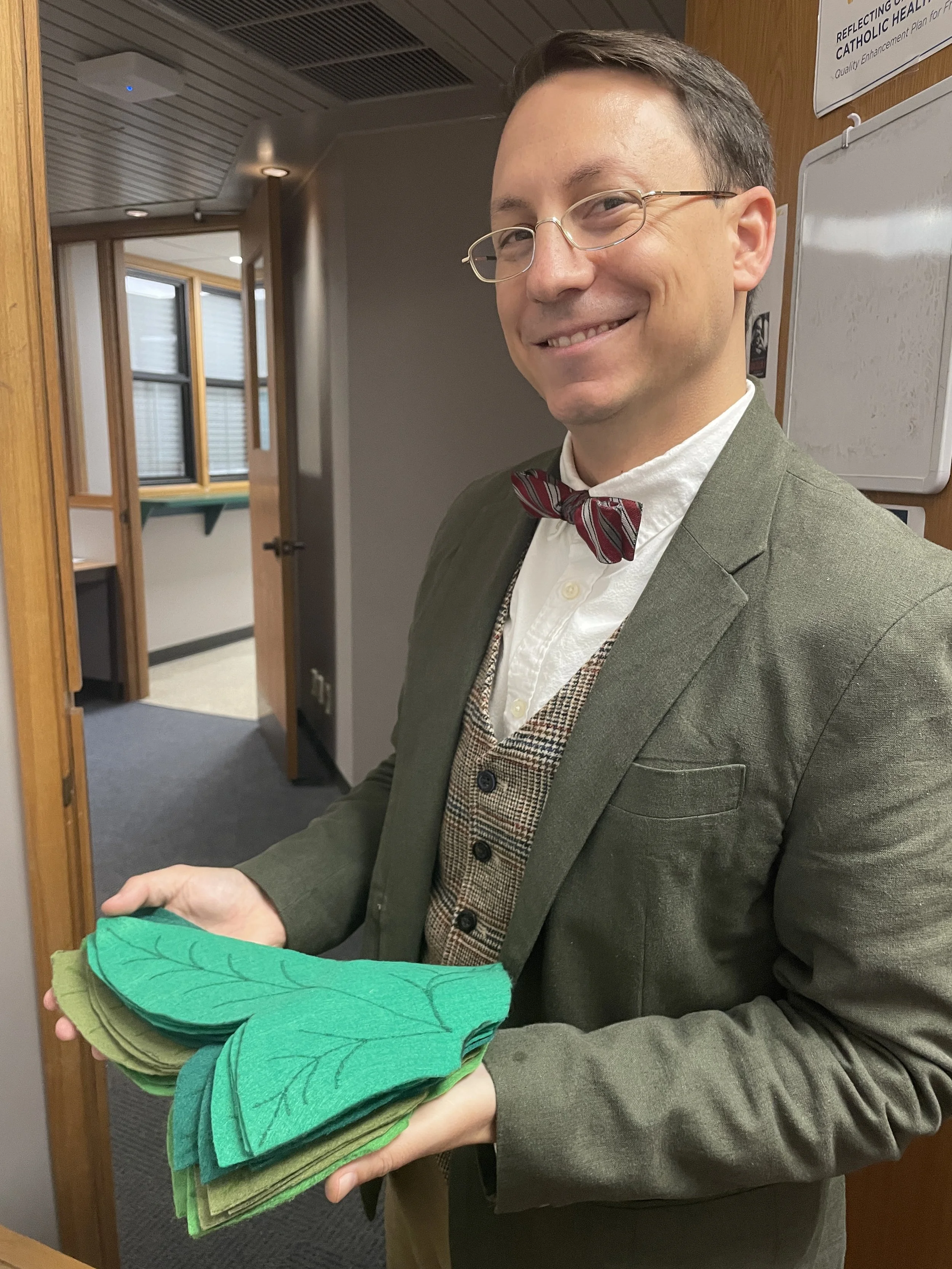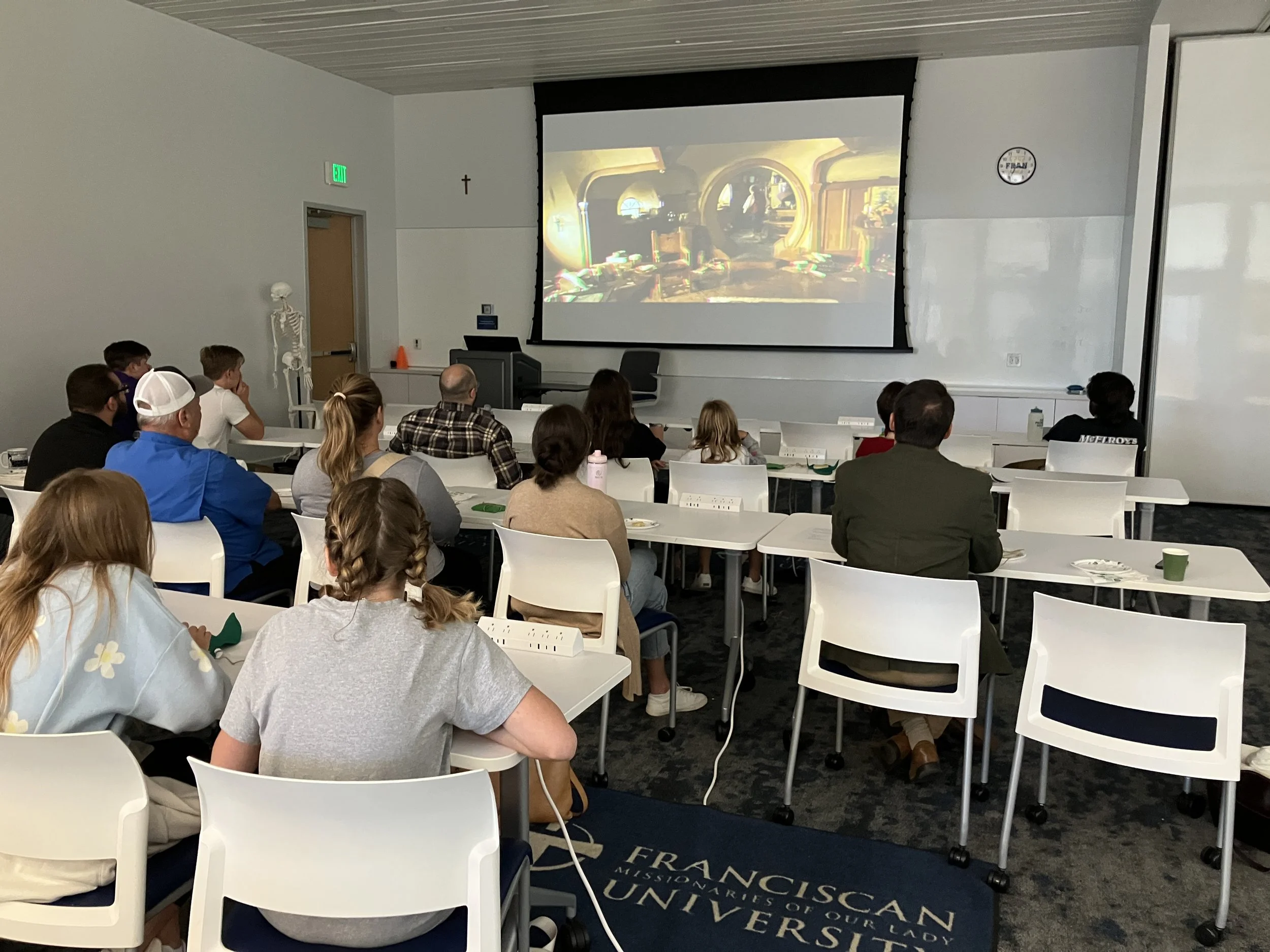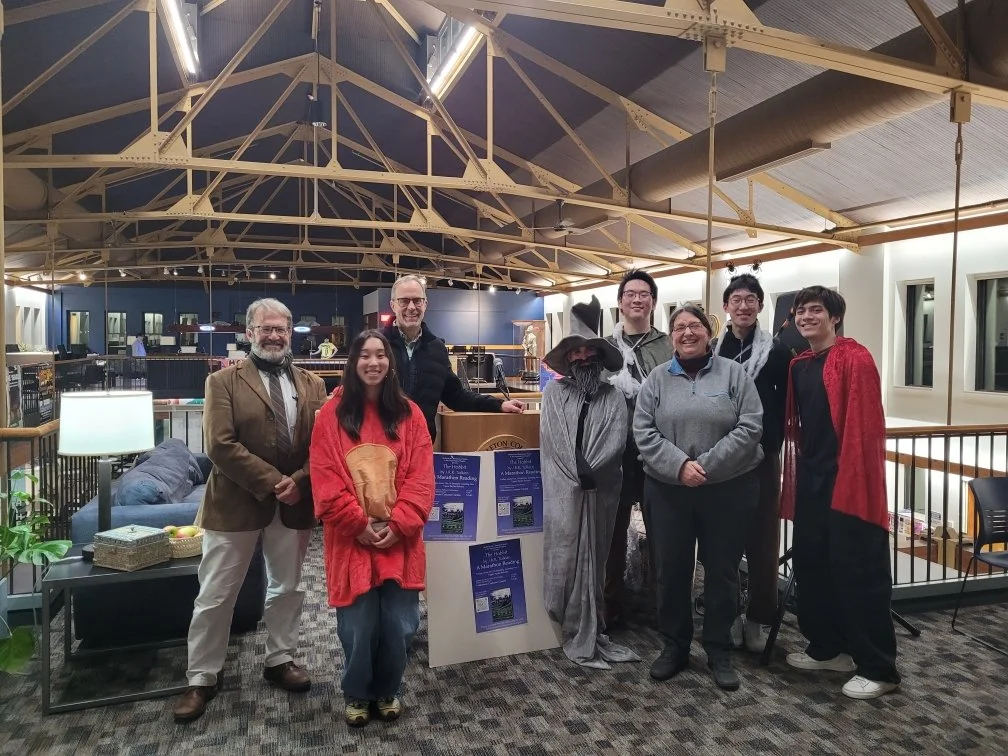IQ 9: Discovering Charles Williams, Tolkien for Medical Humanities, a Hobbit Dinner & Reading Marathon
Inklings Quarterly
November 18, 2025
From Our Fellows
Beware Serpents and Octopuses: On Discovering Charles Williams
Dr. Nicholas Greco and Dr. Michael Gilmour
AY25-26 Inklings Project Fellows
THE CHORUS (within the church)
Fire of the Spirit, life of the lives of creatures … be with us and hear us
THE FLAME
But [outside the church] … an empire …. stretches wide tentacles, gasps and
clutches, and one by one fetches into its maw these ancient scattered islands.
So begins Charles Williams’s 1945 play The House of Octopus. Inside those church walls the faithful experience “the ease and joy of our Lord,” but beyond them oppositional forces await, monstrously embodied in forces loyal to “jade images of octopods,” and a potentially more dangerous spiritual deception: “the cephalopodic process is not only physical.” Wolves in sheep’s clothing. A gripping tale of perseverance and apostasy unfolds.
We first discovered Williams’s unusual brand of storytelling in tandem as part of an informal, two-person book club, dubbed the Damaris Tighe Dissertation Committee, a nod to the protagonist in one of our favourites, The Place of the Lion (1931). As fans of literary horror generally, the appeal was immediate as the Williams stories regularly involve eruptions of the ghastly, the inscrutable, and the supernatural within otherwise ordinary settings (as with the incarnation of Platonic archetypes Damaris witnesses). On a biographical level, Williams’s enthusiasm for ritual resonates with our respective sympathies for Catholicism (Greco) and high church Anglicanism (Gilmour), though perhaps without his penchant for esoterica. Our takeaway after working through the novels, a selection of his poetry, and a couple of biographies—this is good stuff! Wouldn’t it be great to explore this with students?
But alas, Williams is a relative unknown, at least when compared to his more famous Oxford associates. We bandied about the possibility of co-teaching a course on the third Inkling but realized few students would know the name, which led us to frame our Inklings Project syllabus around one of the elements of his strange fiction that appealed most, that inclusion of the preternatural and uncanny, those gasping and clutching wide tentacles, and their equivalents found scattered across his body of work. This is certainly not the only quality of Williams’s fiction that warrants attention but as a marketing strategy and a way to get students ‘in the door,’ we thought this might serve the purpose.
How does Williams use the horrific (broadly defined) as a vehicle for theological reflection? That is what our Project course ENGL 3070 The Scariest Inkling: Studies in Charles Williams (winter 2027) aims to find out. Additionally, and in partial preparation for that course, the syllabus for a previously scheduled one—ENGL 2660 Religious Themes in Literature—now has the subtitle Exploring Theological Horror. The idea is to give students a taste of Charles Williams’s work ahead of next year’s ENGL 3070 (such shameless self-promotion!), and to locate the author in relation to the Inklings (and the Inklings adjacent). The winter 2026 course will therefore centre around three very different works: George MacDonald’s Princess and the Goblin (1872; with a sideways glance at its sequel, The Princess and Curdie [1883]); C. S. Lewis’s The Screwtape Letters (1942); and Williams’s War in Heaven (1930), the latter taught by both of us.
These works vary widely but are alike in their use of characters who manifest darkness––MacDonald’s goblins; Lewis’s devils; Williams’s Gregory Persimmons and Sir Giles Tumulty––as a means of exploring the contrasting light. They tease out theological nuances in different ways, of course, and their respective commentaries on the nature of good vs. evil are both engaging and instructive. To help students appreciate their divergent perspectives, we’ll highlight, among other things, their use of spatial imagery when defining their villains and the threats they pose. MacDonald’s representatives of evil, the goblins, are literally below the good people above (the Princess, her Grandmother, her young rescuer Curdie, and her father King), mining their way up from the depths to despoil the hated realm overhead. A lot of Screwtape’s twisted logic focuses on “the patient’s” interiority: “Keep his mind on the inner life. He thinks his conversion is something inside him and his attention is therefore chiefly turned at present to the states of his own mind.” For his part, Williams depicts evil as inhabiting the everyday, with evil people and forces beside and proximate. In War in Heaven, for instance, the Archdeacon’s first encounter with Persimmons is suggestive: “A large man whose face he dimly remembered was looking over the [Rectory’s] garden gate…. He opened the gate for the stranger, who … entered.” A sheep in wolf’s clothing, a serpent in the Edenic garden, indeed. Or said differently, another manifestation of the monstrous octopods outside the church door.
Again, our focus on the Williams’s thrillers and gravitation toward spooky elements within them is a pedagogical strategy. At the same time, the shadow side of the good news is a frequent theme in the biblical writings themselves and church traditions throughout history. There are devils and demons, serpents and satans all through Christian discourses past and present, and the influence of those concepts and storylines on the arts is inestimable.
One more thought, though. Might Williams’s books function to promote change in the reader and in the world? Williams’s occult sensibilities led him to believe that change was possible through ritual and ‘magic.’ As his characters learn about and experience the work of God (think of, to give but one example, Pauline’s encounter with the theology of “exchange” in Descent into Hell [1937]), so do readers. In this way, reading Williams is a sacramental act, a way of bringing the grace of God into the world, whether the reader knows it or not.
These winter 2026 and winter 2027 courses will explore such recurring features in Williams’s storytelling––his octopuses and serpents––as a pathway into the author’s complex theology.
Nicholas Greco is Provost and Professor of Communications and Media at Providence University College (Manitoba) and the proud owner of a first edition copy of Williams’s A Myth of Shakespeare, signed by the author in 1929. He is fascinated with the life and death of early twentieth century academic and Carmelite Saint Edith Stein who, along with Williams, demonstrates “super empathy.”
Michael Gilmour teaches English literature and New Testament at Providence University College (Manitoba). He doesn’t have a first edition on his shelf but has visited Charles Williams’s grave five times.
Tolkien and Beyond: Teaching Medical Humanities and Educating 21st-Century University Students
Dr. Matías Quer | AY25-26 Inklings Project Fellow
Professor of Ethics and Political Philosophy, Universidad de los Andes, Chile
Unlike many I've met in recent years, my fascination with Tolkien didn't begin with an interest in his work, but rather stems from my admiration for him as a person and his life. It's likely that what first caught my attention about Tolkien was a certain identification with him as a Catholic university professor and convert, as I am myself. The depth of his faith, without ostentation or exaggeration, a beautiful and sober faith, if you will. Of course, I was also drawn to the intensity with which he lived his friendships and his dedication to his family. This starting point led me to reread the Professor's work, which I hadn't read since my youth. In fact, I may have read some of the best biographies and texts about his work almost in parallel while devouring The Silmarillion, The Hobbit, and The Lord of the Rings.
As I delved deeper into his mythological world, I began to discover in each of his works not only a captivating beauty, but also the profound philosophical and theological implications that lie beneath. Thus, the “Ainulindalë” became one of my favorite texts, along with the most cherished passages from The Lord of the Rings. Over the years, my recurrent reading of his complete works allowed me to discover some lesser-known gems, among which the incredible dialogue between Finrod and Andreth, entitled "Athrabeth Finrod ah Andreth," is worth highlighting. In that conversation, as in the story of Númenor and many other passages in Tolkien's texts, one can find a profound insight into the mystery of the human being, its destiny, its origin, its fear of death, and its need for transcendence. For this reason, I believe that Professor Tolkien's work has the capacity to connect with the deepest themes of human existence and allows us to delve into the mysteries that give meaning to human life. Therefore, I believe that a calm reading of some of his texts is a good way to face the challenge of Medical Humanities, which consists of providing a broader perspective on who the human being is and what medicine is, in light of the humanities.
As a member of the Center for Bioethics and Medical Humanities at Universidad de los Andes (Chile), I intend to incorporate Tolkien's work into my teaching of future physicians. At the same time, through my course "Beyond the Lord of the Rings," I have the opportunity to do the same with students from all majors at the university. This course, in addition to developing the fundamental themes of Tolkien's literature in light of Catholic theology, is enriched by the contributions of Lewis and other Inklings, which complement the Professor's perspective on issues such as death, mercy, hope, amity, and sacrifice, among others. For all these reasons, I believe that continuing to study and teach Tolkien and the Inklings is an enriching contribution to the humanistic formation of young university students, who are often captivated by the beauty of their works and, through them, are able to seek goodness and truth.
Fellow Spotlights
Dr. Christopher Ragusa | AY25-26 Inklings Project Fellow
Assistant Professor of Moral Theology, Franciscan Missionaries of Our Lady University
On-Campus Screening of The Fellowship of the Ring, with lembas and a hobbit dinner!
As part of the Inklings Project Fellowship, Dr. Christopher Ragusa held a screening of "The Fellowship of the Ring" at FranU in Baton Rouge, Louisiana to celebrate the 70th anniversary of the publication of "The Return of the King" and the upcoming 25th anniversary of the movies. The goal of the event was to draw students, faculty, and those in the wider community together to watch and discuss The Lord of the Rings. Moreover, the event was also designed to encourage student enrollment in the upcoming Great Books & Theology course at FranU on Lewis & Tolkien: Christianity and Imagination.
The event began with a brief intro to Tolkien and the themes of his trilogy by Dr. Ragusa as well as tea and snacks--including homemade lembas bread. Afterwards, all settled in to watch the movie together. In good hobbit fashion this was followed by a later diner during the intermission of the movie and good conversation and discussion after the movie was finished. All seemed to greatly enjoy the opportunity for good fellowship and a good discussion. Dr. Ragusa and FranU also plan to hold an upcoming Advent event which include caroling as well as the public reading of some of Tolkien's "Letters from Fr. Christmas.”
Dr. Amy Fahey | AY25-26 Inklings Project Fellow
Teaching Fellow, Thomas More College of Liberal Arts
A Lecture on Form and Meaning in Sir Gawain and the Green Knight
In 1953, Tolkien set out to correct what he saw as the chief misinterpretation of Sir Gawain and the Green Knight in his day when he gave the W. P. Ker Memorial Lecture on the poem at the University of Glasgow, later included in essay form in The Monsters and the Critics. There he argued that “the kernel, the very nub of the poem” is the thirtieth stanza of the third fit: everything hinges upon a correct reading of the nature and effect of Gawain’s confession after he’s accepted the girdle and before he sets out for the Green Chapel.
Building on and resituating Tolkien's argument, Dr. Fahey similarly argues that contemporary misreadings of the poem stem from an incorrect understanding of the court's closing laughter and adoption of the green sash as an emblem of renown and honor.
Is Gawain wrong in viewing the green sash as a mark of his shame? Does the court misconstrue and subvert Gawain’s understanding in adopting it as an emblem of renown? Or is there a framework in which Gawain and the court are both correct in assigning it two seemingly incompatible meanings? Dr, Fahey guides the audience through several key passages, in both the original Middle English and modern translations, in order to answer these questions. In so doing, she reveals how a flawed translation or a lack of knowledge of or sympathy with medieval Christendom can distort the poem’s meaning, and reaffirms that, of any translators of the poem, Tolkien gets us closest to the heart of this great medieval romance.
You can read more about this event here and watch the recorded lecture here.
Dr. Timothy Burbery | AY23-24 Inklings Project Fellow
Professor of English, Marshall University
The Hobbit Reading Marathon at Carleton College
Carleton College, where Dr. Burbery is serving as a visting professor this fall, held a reading marathon to close out the month of October. The marathon, which was planned to last13-14 hours, was completed in a mere 10 hours! Faculty and students signed up for 20-minute reading slot. The event was held in Sayles, which is Carleton's student union, and attracted a fair number of passersby who stopped in to listen for a bit. The reader had a microphone, which certainly helped us hear the readers over the quiet din of Sayles, and things quieted down when the evening rolled around. The event also included a costume contest, with prizes awarded to six students, including one dressed as Bilbo.
Dr. Christopher Snyder | AY23-24 Inklings Project Fellow
Professor of European History, Mississippi State University
A Talk on Tolkien and Mythopoeia for the Oxford Tolkien Seminar
This past summer, Dr. Snyder gave a talk a talk on Tolkien and Mythopoeia for the Oxford Tolkien Seminar entitled “The Sub-Creation Theory of J.R.R. Tolkien: Literary Criticism or Theology?" at the University of Oxford. Click here to watch the recorded lecture; click here to learn more about the Oxford Tolkien Network are below.
Quarterly Highlights
Inspiration: “There are no uninteresting things, only uninterested people.” – G. K. Chesterton, “The Hole In The Wall And Other Stories"
Resource: Recommended by Inklings Project fellows, John Hendrix’s graphic novel The Mythmakers: The Remarkable Fellowship of C.S. Lewis & J.R.R. Tolkien illustrates the friendship of two authors who created worlds with their literature. The C. S. Lewis Society of California has recorded a discussion on the book by Mark Hofman which can be found here.
Event: The 2026 C. S. Lewis Writer’s Conference, hosted by the C. S. Lewis Foundation and Cultivating Oaks Press, is taking place May 28-30, 2026 in Colorado Springs. To learn more or register for the event, visit https://www.cslewis.org/events/2026writers/.
Interested in supporting the Inklings Project?
The Inklings Project exists because of the generosity of individuals. To make a one-time or recurring donation to the Inklings Project, please visit giving.nd.edu/inklings, or call 574-631-7164.
The University of Notre Dame is a 501(c) (3) tax exempt nonprofit corporation.
For past issues of the Inklings Quarterly, visit www.inklingsproject.org/quarterly.


















